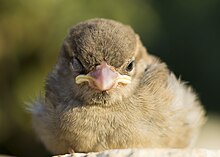
Unihemispheric slow-wave sleep (USWS) is sleep where one half of the brain rests while the other half remains alert. This is in contrast to normal sleep where both eyes are shut and both halves of the brain show unconsciousness. In USWS, also known as asymmetric slow-wave sleep, one half of the brain is in deep sleep, a form of non-rapid eye movement sleep and the eye corresponding to this half is closed while the other eye remains open. When examined by electroencephalography (EEG), the characteristic slow-wave sleep tracings are seen from one side while the other side shows a characteristic tracing of wakefulness.[1] The phenomenon has been observed in a number of terrestrial, aquatic and avian species.
Unique physiology, including the differential release of the neurotransmitter acetylcholine, has been linked to the phenomenon.[1] USWS offers a number of benefits, including the ability to rest in areas of high predation or during long migratory flights. The behaviour remains an important research topic because USWS is possibly the first animal behaviour which uses different regions of the brain to simultaneously control sleep and wakefulness.[2] The greatest theoretical importance of USWS is its potential role in elucidating the function of sleep by challenging various current notions. Researchers have looked to animals exhibiting USWS to determine if sleep must be essential; otherwise, species exhibiting USWS would have eliminated the behaviour altogether through evolution.[3]
The amount of time spent sleeping during the unihemispheric slow-wave stage is considerably less than the bilateral slow-wave sleep. In the past, aquatic animals, such as dolphins and seals, had to regularly surface in order to breathe and regulate body temperature. USWS might have been generated by the need to perform these vital activities simultaneously with sleep.[4]
On land, birds can switch between sleeping with both hemispheres to one hemisphere. Due to their poorly webbed feet and long wings, which are not completely waterproof, it is not energetically efficient for them to make rest stops or land on water, only to take flight again. Using unihemispheric slow-wave sleep, birds are able to maintain environmental awareness and aerodynamic control of wings while obtaining the necessary sleep they need to sustain attention during wakefulness. Their sleep is more asymmetric in flight than on land, and they sleep mostly while circling air currents during flight. The eye connected to the awake hemisphere of their brain is the one facing the direction of flight. Once they land, they pay off their sleep debt, as their REM sleep duration significantly decreases and slow-wave sleep increases.[5]
Despite the reduced sleep quantity, species having USWS do not present limits at a behavioral or healthy level. Cetaceans, such as dolphins, show preserved health as well as great memory skills. Indeed, cetaceans, seals, and birds compensate for the lack of complete sleep with efficient immune systems, preserved brain plasticity, thermoregulation, and restoration of brain metabolism.[4]
- ^ a b Lapierre, Jennifer L.; Kosenko, Peter O.; Lyamin, Oleg I.; Kodama, Tohru; Mukhametov, Lev M.; Siegel, Jerome M. (2007). "Cortical Acetylcholine Release Is Lateralized during Asymmetrical Slow-Wave Sleep in Northern Fur Seals". The Journal of Neuroscience. 27 (44): 11999–12006. doi:10.1523/JNEUROSCI.2968-07.2007. PMC 6673386. PMID 17978041.
- ^ Cite error: The named reference
Half-awakewas invoked but never defined (see the help page). - ^ Cirelli, Chiara; Tunoni, Giulio (2008). "Is Sleep Essential?". PLOS Biology. 6 (8): 1605–1611. doi:10.1371/journal.pbio.0060216. PMC 2525690. PMID 18752355.
- ^ a b Mascetti, Gian Gastone (2016). "Unihemispheric sleep and asymmetrical sleep: Behavioral, neurophysiological, and functional perspectives". Nature and Science of Sleep. 8: 221–238. doi:10.2147/NSS.S71970. PMC 4948738. PMID 27471418.
- ^ Rattenborg, N. C.; Lima, S. L.; Amlaner, C. J. (1999-11-15). "Facultative control of avian unihemispheric sleep under the risk of predation". Behavioural Brain Research. 105 (2): 163–172. doi:10.1016/s0166-4328(99)00070-4. ISSN 0166-4328. PMID 10563490. S2CID 8570743.